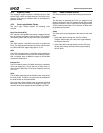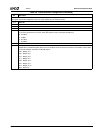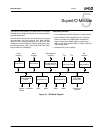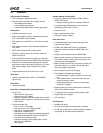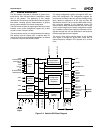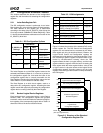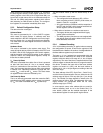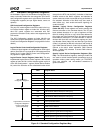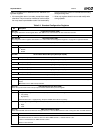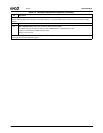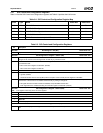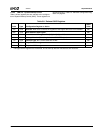
AMD Geode™ SC3200 Processor Data Book 91
SuperI/O Module
32581C
Write accesses to unimplemented registers (i.e., accessing
the Data register while the Index register points to a non-
existing register or the LDN is 07h or higher than 08h), are
ignored and a read returns 00h on all addresses except for
74h and 75h (DMA configuration registers) which returns
04h (indicating no DMA channel is active). The configura-
tion registers are accessible immediately after reset.
5.3.3 Default Configuration Setup
The device has four reset types:
Software Reset
This reset is generated by bit 1 of the SIOCF1 register,
which resets all logical devices. A software reset also
resets most bits in the SIO Configuration and Control regis-
ters (see Section 5.4.1 on page 95 for the bits not affected).
This reset does not affect register bits that are locked for
write access.
Hardware Reset
This reset is activated by the system reset signal. This
resets all logical devices, with the exception of the RTC and
the SWC, and all SIO Configuration and Control registers,
with the exception of the SIOCF2 register. It also resets all
SuperI/O control and configuration registers, except for
those that are battery-backed.
V
PP
Power-Up Reset
This reset is activated when either V
SB
or V
BAT
is powered
on after both have been off. V
PP
is an internal voltage
which is a combination of V
SB
and V
BAT
. V
PP
is taken from
V
SB
if V
SB
is greater than the minimum (Min) value defined
in Section 9.1.4 "Operating Conditions" on page 352; oth-
erwise, V
BAT
is used as the V
PP
source. This reset resets
all registers whose values are retained by V
PP.
V
SB
Power-Up Reset
This is an internally generated reset that resets the SWC,
excluding those SWC registers whose values are retained
by V
PP
. This reset is activated after V
SB
is powered up.
The SIO module wakes up with the default setup, as fol-
lows:
• When a hardware reset occurs:
— The configuration base address is 2Eh, 15Ch or
None, according to the IO_SIOCFG_IN bit values, as
shown in Table 5-1 on page 90.
— All Logical devices are disabled, with the exception of
the RTC and the SWC, which remains functional but
whose registers cannot be accessed.
• When either a hardware or a software reset occurs:
— The legacy devices are assigned with their legacy
system resource allocation.
— The AMD proprietary functions are not assigned with
any default resources and the default values of their
base addresses are all 00h.
5.3.4 Address Decoding
A full 16-bit address decoding is applied when accessing
the configuration I/O space, as well as the registers of the
functional blocks. However, the number of configurable bits in
the base address registers vary for each device.
The lower 1, 2, 3 or 4 address bits are decoded within the
functional block to determine the offset of the accessed
register, within the device’s I/O range of 2, 4, 8 or 16 bytes,
respectively. The rest of the bits are matched with the base
address register to decode the entire I/O range allocated to
the device. Therefore the lower bits of the base address
register are forced to 0 (RO), and the base address is
forced to be 2, 4, 8 or 16 byte aligned, according to the size
of the I/O range.
The base address of the RTC, Serial Port 1, Serial Port 2,
and the Infrared Communication Port are limited to the I/O
address range of 00h to 7Fxh only (bits [15:11] are forced
to 0). The Parallel Port base address is limited to the I/O
address range of 00h to 3F8h. The addresses of the non-
legacy devices are configurable within the full 16-bit
address range (up to FFFxh).
In some special cases, other address bits are used for
internal decoding (such as 10 in the Parallel Port). For
more details, please see the detailed description of the
base address register for each specific logical device.




